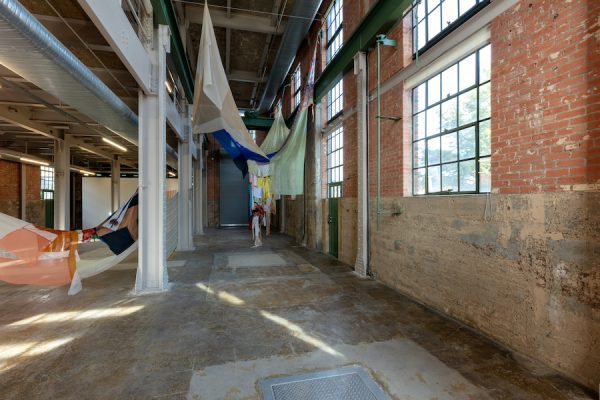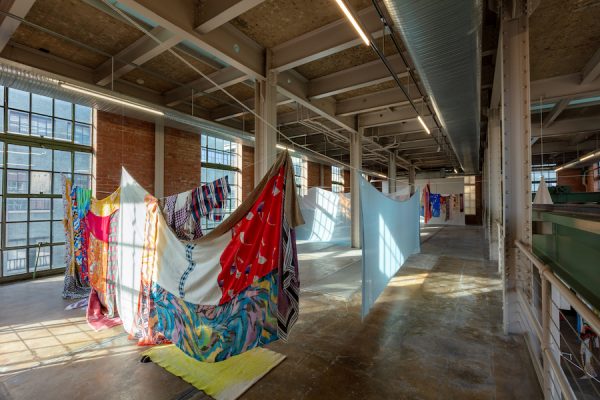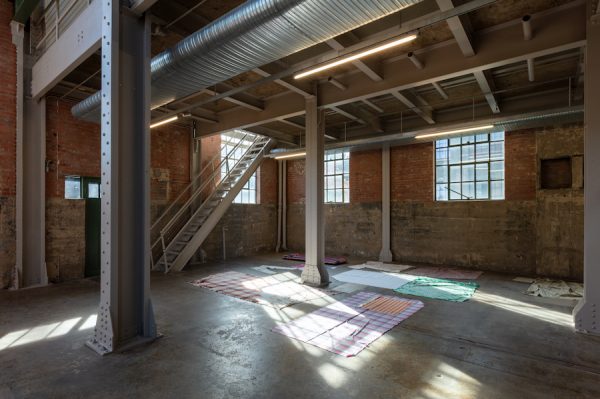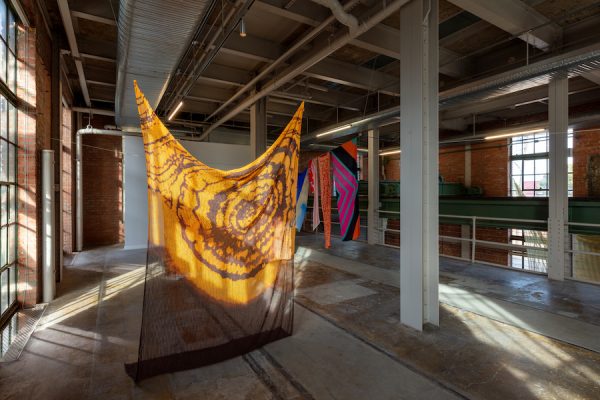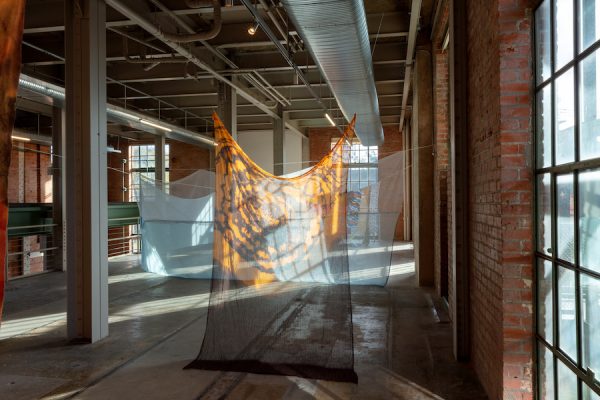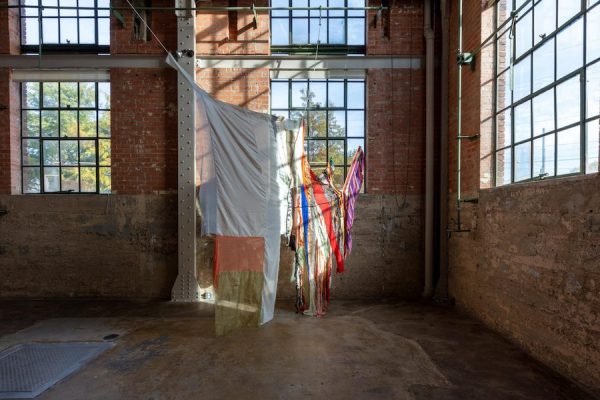
Eric N. Mack, Modern Comfort, 2019. Fabric, thread, pins and rope. 113 1/2 x 100 x 26 inches. Photos: Kevin Todora
I had the good fortune to meet with Eric N. Mack on two occasions before he finished installing his exhibition In austerity, stripped from its support and worn as a sarong at The Power Station in Dallas. Soft-spoken and sharply intelligent, Mack provided insight into his process, and the productive mix of anxiety and self-assuredness that enabled him to tackle the challenging split-level space.
I visited Mack on the Tuesday and Thursday before the opening on Friday, October 25th. On each of those days, his assemblages significantly shifted around the building, off the floor, across the room, or created a new division in the space. When I asked Mack about his editing process, he told me: “I have this note to myself that says the work should flow like a haircut, like raggedy bangs, you know? Cutting the excess, getting to the central form. Reorganizing the central form.”
But given how the work spreads throughout the space, it’s difficult to identify what the central form of In austerity is. The pieces of fabric, ranging from printed scarves to transparent synthetics to bleached and tie-dyed muslin, are either pinned, sewn together or presented individually on the floor or hung from lines. When I attended the opening to see the final result, it felt like an installation that was, perhaps, still in flux. The pieces on the floor seemed to be waiting to be utilized, whereas the hanging work made tenuous, tentative links with the environment around them. The works touched spots all around the space, crossing over each other, reaching as high as they could and as far as the building’s dimensions would allow. As I watched the installation progress, I imagined the large fabric works stretching to feel a hard-to-reach corner, grasping and releasing, settling later on a spot that felt more right. Mack said, “I really want it to feel like the work dissolves into light, color, shape, form, but for it to be able to move around the space, to hover, fly around the room, and end up on the ground.”
The Bronx-based artist was able to make one site visit this past summer, and prepared some of the work in his studio before arriving for a week of install. He shipped a few large boxes of materials, which were sourced mainly in New York City from vintage shops, thrift stores, and his many collaborators. When he got to Dallas he set up his sewing machine in the corner on the first floor, and got to work. Mack was particularly inspired by the previous installations of Oscar Tuazon and Michael E. Smith: “How they were able to use that space in such a particularly sensitive way, or as a container for their practice. A container for an idea.” That container has connotations of industry, labor, mechanisms, and bodies at work. “[Those] feel like a good counterpoint to some of the work I do, some of the gestural qualities, things that are seemingly soft and fragile.” And while the material imparts a feeling of fragility and lightness, Mack says that this show is “about a context of strength and intentionality, as a space to structure a kind of contrasting element into reality. Something soft, diaphanous, but also varied, flexible, able to fold, expand, to constrict. Those being really powerful qualities, actually.”
Although loose fabric is as materially opposed to steel, concrete, glass and brick as it could possibly be, Mack’s works thrive within The Power Station’s industrial architecture. Elements of the building resonate with certain parts of his pieces. A green swatch of cloth echoes an old green door in the wall opposite the entrance, and the panes of glass in the windows repeat not only through the textiles, but in the patchwork construction as well. The cotton cord from which the work upstairs hangs is similar in its tautness and perpendicularity to the cables on the handrails and the conduit fixed to the ceilings. Most fluently, Mack’s work speaks the language of painting. The exclusive use of colored cloth, aside from the wryly placed air mattress on the first floor, is formally tied to painting. The thing that is stripped from its support is the painting, and it’s worn as a sarong, assuming the form of, in this case, the space inside the building. The works on the floor playfully refer to flatness in painting, while the makeshift fabric walls upstairs challenge it as they drape to the floor and sag, and the billowy tent-like hanging works outright deny it.
What struck me most about Mack’s installation is that, unlike previous shows I’ve seen at The Power Station, he didn’t build out the space in any way. His as-is approach strengthened the work, and without modifications or customization, Mack was able to put on a dynamic, ebullient performance within the space provided. And don’t let the wrinkles offend you; they enrich with their visual tactility.
After his ever-changing spatial collage Lemme walk across the room at the Brooklyn Museum in 2018, and his strong showing during the 2019 Whitney Biennial, Mack’s debut in Dallas delivers even more, by pushing the space to its limits in a beautifully choreographed installation. “There was a certain amount of audacity that I had to employ to begin. I was like, ‘OK. I need to freak it in there,’ you know?”
On view by appointment at the Power Station, Dallas, through December 13.


